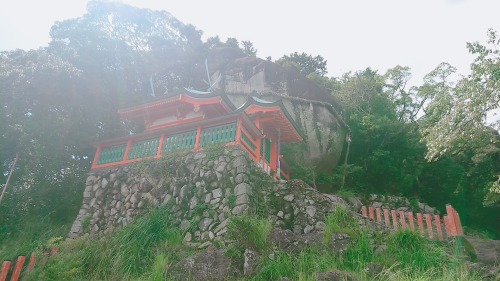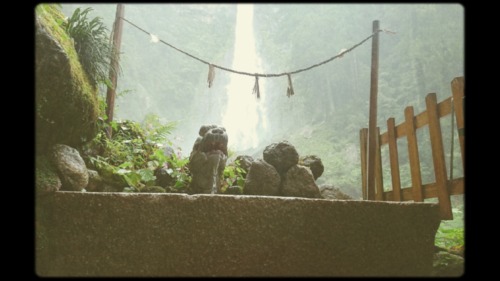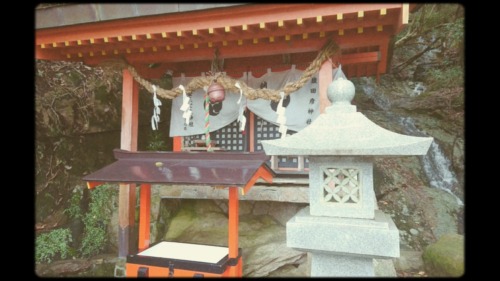As western civilizations move toward the season of spirits and ghouls, most eastern traditions have already wrapped up festivals and holidays related to the visitation of ancestral spirits, but that shouldn't stop you from getting a quick, spiritual pick-me up during the fall season.
Japan is something of a religious paradox. While there are over 150,000 temples and shrines (temples are for Buddhism, while shrines are for Shintoism) throughout the country, most Japanese people do not consider themselves religious and, disregarding the fact that the emperor is supposed to be a descendant of the sun god, the government is very secular as well. That doesn't stop every prefecture in the country from touting it's local power spots known to do everything from help you win the lottery to pass an entrance exam for school.
And it is not uncommon for the Japanese to float effortlessly between both Buddhist and Shinto celebrations, with some modern seasonal celebrations being a combination of the two. For example, Japanese Wikipedia says that the Obon celebration (which takes place in summer) was born from a combination of ancient Japanese ancestor worship (which originally occurred twice a year) and Buddhist traditions. Another celebration, Shichi-Go-San, is a celebration that can be performed at a shrine or a temple.
With all that being said, for those looking to make a power spot trip to Japan that may be too short on time to visit the many different power spots throughout the country, I have 3 power spots that are sure to give you the spiritual boost you've been looking for.
All of these power spots are located in Wakayama Prefecture, known as something of hot spot for religion. While it doesn't have the most shrines (that honor goes to Niigata) or the most temples (that goes to Aichi), Wakayama's religious tourism program is probably the largest in the country.
Between temple homestays at the many temples on Mt. Koya to the Kumano pilgrimage trail that takes travelers on a 70 kilometer journey of through the mountains, Japanese and international tourists alike descend on the area all year round to absorb whatever power they can.
[gotobiki power spot]
 |
| Taken from the base of the stairs leading to the tiny shrine below the rock |
A lot of Japanese power spot blogs have labeled this as one of Japan's most powerful because it said to be the place where the great god of Kumano (熊野権現) descended to earth. Additionally, the Nihon Shoki (a history of ancient Japan) says that Emperor Jinmu visited this very same rock during his one of his journeys.
Personally, I found the location to be extremely relaxing, especially when compared to other shrines I've been to. I do believe that's owing to the fact that it's rather hard to get to, which is unfortunate for older visitors of the shrine.
[nachi falls power spot]
 |
| Nachi Falls |
Probably my favorite spot in all of Wakayama, and maybe my favorite waterfall in all of Japan, Nachi Falls is a famous and very popular power spot on the Kumano trail.The waterfall has long been used for nature worship and is the origin of the Nachi religious faith (now part of the Kumano faith).
There is no charge to walk through the shrine to the waterfall, but if you want to get a little closer, there is a 300 yen fee. With that 300 yen, you will also be allowed to use a fountain where you can collect water from the waterfall to take with you. They even have commemorative little saucers you can buy.
 |
| Shota and I bought the saucers for our kamidana at home. |
[kumano hongu grand shrine power spot]
 |
| A long queue to pray at the main shrine. |
The grand shrine is, actually, not near the previous two spots. It's about an hour drive away, tucked deep in the mountains. So those traveling by public transport, you've been warned. Luckily, there is a large culture center in front of the shrine with buses that seem to run through fairly often. And as you can see from the photo above, even on a rainy day, it is very popular!
This shrine also has a large flight of steps leading up to the main structure, and there are several different places to pray at throughout the grounds. There are also a few hiking courses that will lead you into the mountains that range anywhere from 2 to 4 hours long. All of this information can be found in the culture center by the shrine.
Close to the main shrine is the old site for the same shrine. It was flooded during the Meiji era and rebuilt in its current location, but some of the foundation and the large torii are still there for you to visit (and much less crowded).
For a slightly more enjoyable presentation of our trip, check out this video I made!
This was our first time visiting the main Kumano shrine, but our second time visiting the falls, and though I think we'll be visiting again soon, I doubt I'll be making anymore blogs or videos about. So, if you have any questions about visit or about the sites themselves, feel free to comment on this point or on the YouTube video and I'll be sure to get back to you!
★Peaces★






